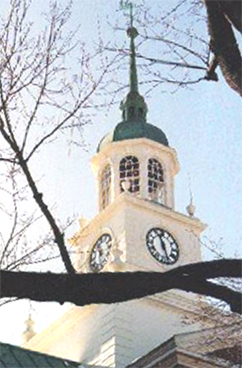Stephenson:Neal:Cryptonomicon:10:separate thing called IAS (Alan Sinder)
From the Quicksilver Metaweb.
This is the Cryptonomicon page for the Institute for Advanced Study.
Stephensonia
A modestly curious person should note both the InterLibrary Loan (ILL) and the IAS are both mentioned in George Dyson's Darwin Among the Machines, the Evolution of Global Intelligence. Lawrence Waterhouse ends up in Princeton for a year as a way to make him more worldly:

All Around the Clocktower
*
Now Princeton was an august school and going there was a great honor, but no one got around to mentioning either of these facts to Lawrence, who had no way of knowing. This had bad and good consequences. He accepted the scholarship with a faintness of gratitude that infuriated the oat lord. On the other hand, he adjusted to Princeton easily because it was just another place. It reminded him of the nicer bits of Virginia, and there were some nice pipe organs in town, though he was not all that happy with his engineering homework of bridge-designing and sprocket-cutting problems. As always, these eventually came down to math, most of which he could handle easily. From time to time he would get stuck, though, which led him to the Fine Hall: the headquarters of the Math Department.
There was a motley assortment of fellows wandering around in Fine Hall, many sporting British or European accents. Administratively speaking, many of these fellows were not members of the Math Department at all, but a separate thing called IAS, which stood for Institute for Advanced something-or-other. But they were all in the same building and they all knew a thing or two about math, so the distinction didn't exist for Lawrence. ***
Authored entries
- TBA
Wikipedia: Institute for Advanced Study
The Institute for Advanced Study is a private institution in Princeton Township, New Jersey, designed to foster pure cutting-edge research by scientists in a variety of fields without the complications of teaching or funding, or the agendas of sponsorship. It is perhaps best known as the academic home of Albert Einstein after his immigration to the United States.
The School
The Institute consists of a School of Historical Studies, a School of Mathematics, a School of Natural Sciences, a School of Social Science, and a newly created program in Theoretical Biology. There is a small permanent faculty for each school, supplemented by the Visiting Members who are selected for fellowships each year. One might discern a certain ideology behind such an unusual collection of disciplines, although it is probably more accurate to say that the Institute has been distinguished more by the strong personalities that have passed through it over the years than any particular "mission statement."
There are no degree programs or experimental facilities at the Institute, and research is funded by endowments, grants and gifts -- it does not support itself with tuition or fees. It is not part of any educational system, however the proximity of Princeton University (three miles between its science departments and the main Institute complex) means that informal ties are close and a large number of collaborations have arisen over the years.
Research is never contracted or directed; it is left to each individual researcher to pursue their own goals.
History
The institute was founded in 1930 by Louis Bamberger and Caroline Bamberger Fuld with the proceeds from their Newark department store. The founding of the institute was fraught with brushes against near-disaster; the Bamberger siblings pulled their money out of the stock market just before the Stock Market Crash of 1929, and their original intent was to express their gratitude to the state of New Jersey through the founding of a dental school. It was the intervention of their friend Dr. Abraham Flexner that convinced them to put their money in the service of more abstract research.
Faculty (need more on faculty members present and past)
Stephen L. Adler, James W. Alexander, Andrew E. Z. Alföldi, Michael F. Atiyah, John N. Bahcall, Arne K. A. Beurling, Enrico Bombieri, Armand Borel, Jean Bourgain, Glen W. Bowersock, Caroline Walker Bynum, Luis A. Caffarelli, Harold F. Cherniss, Marshall Clagett, Giles Constable, Patricia Crone, José Cutileiro, Roger F. Dashen, Pierre Deligne, Nicola di Cosmo, Freeman J. Dyson, Edward M. Earle, Albert Einstein, John H. Elliott, Clifford Geertz, Felix Gilbert, James F. Gilliam, Kurt Gödel, Hetty Goldman, Peter Goldreich, Oleg Grabar, Phillip A. Griffiths, Christian Habicht, Harish-Chandra, Ernst Herzfeld, Albert O. Hirschman, Lars V. Hörmander, Piet Hut, Jonathan Israel, Ernst H. Kantorowicz, George F. Kennan, Robert P. Langlands, Irving Lavin, T. D. Lee, Elias A. Lowe, Robert D. MacPherson, Juan Maldacena, Eric S. Maskin, Jack F. Matlock, Jr., Millard Meiss, Benjamin D. Meritt, John W. Milnor, David Mitrany, Deane Montgomery, Marston Morse, J. Robert Oppenheimer, Abraham Pais, Erwin Panofsky, Peter Paret, Tullio E. Regge, Winfield W. Riefler, Marshall N. Rosenbluth, Joan Wallach Scott, Nathan Seiberg, Atle Selberg, Kenneth M. Setton, Carl L. Siegel, Thomas Spencer, Walter W. Stewart, Bengt G. D. Strömgren, Homer A. Thompson, Kirk Varnedoe, Oswald Veblen, Vladimir Voevodsky, John Von Neumann, Heinrich Von Staden, Michael Walzer, Robert B. Warren, André Weil, Hermann Weyl, Morton White, Hassler Whitney, Avi Wigderson, Frank Wilczek, Edward Witten, Ernest Llewellyn Woodward, C. N. Yang, Shing-Tung Yau
Related entries
- Albert Einstein
- Richard Feynman - gave his nanotechnology speech there I believe...
- Alan Turing
- Kurt Gödel
External link
ISBN 0738200301 Darwin Among the Machines, the Evolution of Global Intelligence by George B. Dyson